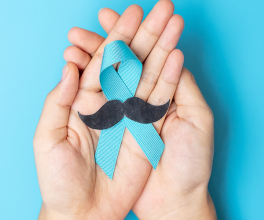
Olympus Marks International Men’s Health Week with Four Myth Busters
International Men’s Health Week is celebrated every year around Father’s Day. This year it will run from June 13-19, 2022, to help increase awareness of preventable health issues and promote early detection and treatment for men of all ages.
It is no secret that men face cultural challenges and norms that may impact how well they take care of themselves and get regular checkups, compared to women. In the U.S., research has shown that men engage in more than 30 risky behaviors, including smoking and drinking five alcoholic beverages daily.1 Added to men’s challenges are misconceptions or false assumptions of risk.
To support the mission of International Men’s Health Week and provide additional education and promote awareness, below are some common health myths provided with some context to clear up any confusion.
 MYTH: Men can’t get breast cancer.
MYTH: Men can’t get breast cancer.
Although male breast cancer accounts for less than 1% of all breast cancer diagnoses worldwide, it does happen. Possibly due to its rarity, male breast cancer is more often diagnosed at an advanced stage – possibly stage 3 or 4. It is generally treated the same as female breast cancer, but more studies are needed to help understand and treat it.2
Warning signs to watch for may include a lump or swelling that can sometimes be painless, skin dimpling or puckering, nipple retraction, redness or scaling of the nipple or breast skin, or discharge from the nipple.3 If you are experiencing any of these symptoms, please contact your healthcare provider and seek medical advice. Just because it is rare doesn’t mean that it is impossible.
 MYTH: If you don’t have any symptoms, you don’t have prostate cancer.
MYTH: If you don’t have any symptoms, you don’t have prostate cancer.
As with many illnesses, people tend to wait for symptoms to indicate a problem before contacting a doctor. However, early prostate cancer does not usually cause symptoms. Men diagnosed with cancer at a later stage may experience blood in the urine or problems urinating, but these are likely caused by something other than prostate cancer.4
Unfortunately, the benefits of early screening for prostate cancer are still being determined. According to the American Cancer Society, prostate cancer can often be found early by testing for prostate-specific antigen (PSA) levels in a person’s blood or a digital rectal exam (DRE). Abnormal test results will lead to further analysis, such as a prostate biopsy, to see if cancer exists.5
“But neither the PSA test nor the DRE is 100% accurate. These tests can sometimes have abnormal results even when a man does not have cancer (known as a false-positive result), or normal results even when a man does have cancer (known as a false-negative result).”5
The American Cancer Society recommends until more information is available, that an asymptomatic individual consult with their physician to determine if early screening is the best option.5
 MYTH: BPH only affects men in their 70s and 80s.
MYTH: BPH only affects men in their 70s and 80s.
False! Although it is common knowledge that the prevalence of benign prostatic hyperplasia (BPH) rises notably with increased age, BPH rates for men in their 60s can run from 50% to 60%, increasing from 80% to 90% in men over 70. Half of all men over the age of 50 have evidence of BPH, with rates in the U.S. as high as 70% in those between 60 and 69 years of age.6
Symptoms of BPH may include difficulty or frequent need to urinate, a weak stream, sleep interruption, leakage, sexual dysfunction and more. If you are experiencing any of these symptoms, regardless of age, contact your physician for additional information.
 MYTH: BPH Equals Cancer
MYTH: BPH Equals Cancer
The “b” in BPH stands for benign, meaning that a condition is not cancerous, nor does it lead to cancer.7 With age comes an increased risk of prostate problems. The three most common prostate problems are inflammation (prostatitis), enlarged prostate (BPH), and prostate cancer.8
There is misinformation out there that if you are diagnosed with BPH, that you will also get prostate cancer. According to the National Cancer Institute, “BPH is not linked to cancer and does not increase your risk of getting prostate cancer – yet the symptoms for BPH and prostate cancer can be similar.” They also indicate that having one of these conditions does not increase your risk of experiencing an additional prostate condition, but some men may experience more than one condition at the same time.8
For more information on:
• Prostate cancer, visit: the American Cancer Society
• BPH, visit: Olympus’ Website
1. Williams D. R. (2003). The health of men: structured inequalities and opportunities. American journal of public health. Accessed May 2022.
2. Yalaza, M., İnan, A., & Bozer, M. (2016). Male Breast Cancer. The journal of breast health, 12(1), 1–8. Accessed May 2022.
3. American Cancer Society. (2018). Signs and Symptoms of Breast Cancer in Men. Accessed May 2022.
4. Cancer.org. (August 2019) Signs and Symptoms of Prostate Cancer. Accessed May 2022.
5. Cancer.org. (August 2019) Can Prostate Cancer Be Found Early? Accessed May 2022.
6. National Cancer Institute (NCI). Understanding Prostate Changes: A Health Guide for Men. Accessed May 2022.
7. Ng M, Baradhi KM. Benign Prostatic Hyperplasia. [Updated 2021 Aug 11]. In: StatPearls [Internet]. Treasure Island (FL): StatPearls Publishing; 2022 Jan. Accessed May 2022.
8. Urology Care Foundation. (September 2021) What is Benign Prostatic Hyperplasia (BPH)? Accessed May 2022.





